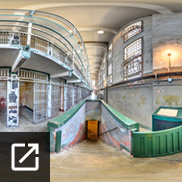
Two closed-off stairwells lead down from the first floor of the Alcatraz Cellhouse to a lower, blocked-off basement level called the Citadel, one of the earliest structures on Alcatraz. The still-intact walls of the Citadel contain a collection of markings that offer clues to understanding Alcatraz’s complex recent history as a military fort, military prison, and finally a federal penitentiary.
In 2016, architect Paul Davidson and Avidan Fernandez documented the Citadel as part of the National Park Service’s Historic American Buildings Survey by collecting data using laser scanning, photogrammetry and remote sensing. With the data they collected, Davidson, Fernandez, and colleague Ryan Pierce produced a virtual tour, fly-through animation, and 3D models.
In his work, Davidson was most compelled by the several generations of wall markings that can be seen throughout the Citadel.
“Whenever I go into a historic building, I’m always looking for clues to how people have used this space or passed through it,” Davidson said.
Used for some of the most severe and inhumane forms of solitary confinement during the military and federal prison chapters on Alcatraz, the Citadel has walls etched with names of formerly incarcerated people, which can be seen in the 3D Models: Photogrammetry models of Citadel wall markings.
Phillip Grosser was a conscientious objector who refused the draft in World War I, and was forced into confinement on Alcatraz from June 1919 to December 1920. Grosser was subjected to many 14-day-long periods of solitary confinement in the Citadel—complete darkness, a cold, damp climate, rodent infestations, no bed, a bucket toilet, and an insufficient diet of bread and water. Such ruthless conditions are what led Grosser to call the Citadel the “dungeon” in his 32-page pamphlet, Uncle Sam's Devil's Island. Grosser carved the number assigned to him at Alcatraz, #11461, into bricks in the Citadel.
According to the last stop on the virtual tour at the West Stair, formerly incarcerated individuals were escorted down one set of stairs to the basement level and brought up the other set of stairs on the opposite side of the building at the end of solitary confinement. This meant that others saw them “go down the stairs but never saw them return—a psychological tactic” used to incite fear and concern.
The once three-story Citadel, a barracks surrounded by a dry moat and built in 1859, was part of Alcatraz’s chapter as a military fort. In 1908, the upper two stories of the Citadel were demolished to make way for construction of a military prison, but the lowest level of the Citadel was kept and buried for use as the foundation. The fly-through animation of the Citadel displays its layout in comparison to the cellhouse, providing a birds-eye-view of its many rooms and corridors.
Today, the basement level of the Citadel is still intact under the cellhouse. Due to concerns over visitor safety, the Citadel is not open to Alcatraz visitors for interpretation. Through the digital resources on this page, this site and its history can be observed and interpreted virtually.






